Microstructure and Properties of Nonlinear Lap Joint of 6061 Aluminum Alloy by Friction Stir Welding
Abstract
:1. Introduction
2. Materials and Methods
3. Results
3.1. Macro Topography of Joints
3.2. Microstructure of Joints
3.3. Microhardness of Joint
3.4. Mechanical Properties of the Joint
4. Conclusions
- (1)
- For 6061-T6 aluminum alloy lap joint friction stir welding with a smaller radius (R < 7 mm), there is a more severe accumulation of welding material. When the radius exceeds 7 mm, good macroscopic joint formation can be achieved.
- (2)
- The FSWed lap joint of a 6061-T6 aluminum alloy can be divided into four zones: WNZ, THAZ, HAZ, and BM. These zones consist of α-Al and intermetallic precipitation β phases. The HAZ had a coarse microstructure, while the WNZ had a fine microstructure with partial dissolution of the β phases. The grain size in the middle of the WNZ was larger than that at the two ends, and the grain size on the inner side of the corner was larger than that on the outer side.
- (3)
- The hardness distribution of the joint showed a “W” shape. The hardness points of the WNZ were slightly higher than the hardness in the TMAZ and HAZ regions. The lowest hardness point was observed in the inner side of the corner in the HAZ.
- (4)
- When R ≤ 7, with an increase in R, the shear strength of the friction stir welded joints increased, and then the change became relatively small. The maximum shear strength of the joint was 101.32 ± 6.89 MPa at R = 7, and the fracture mode was primarily a ductile mixed fracture.
Author Contributions
Funding
Institutional Review Board Statement
Informed Consent Statement
Data Availability Statement
Conflicts of Interest
References
- Thomas, W.M.; Nicholas, E.D.; Needham, J.C.; Murch, M.G.; Templesmith, P.; Dawes, C.J. Friction Stir Butt Welding. UK Patent No. 9125978.8, 6 December 1991. [Google Scholar]
- Sajed, M.; Guerrero, J.W.G.; Derazkola, H.A. A Literature Survey on Electrical-Current-Assisted Friction Stir Welding. Appl. Sci. 2023, 13, 1563. [Google Scholar] [CrossRef]
- Ahmed, M.M.; El-Sayed Seleman, M.M.; Fydrych, D.; Çam, G. Friction Stir Welding of Aluminum in the Aerospace Industry: The Current Progress and State-of-the-Art Review. Materials 2023, 16, 2971. [Google Scholar] [CrossRef] [PubMed]
- Nagira, T.; Liu, X.; Ushioda, K.; Fujii, H. Microstructural evolutions of 2n grade pure al and 4n grade high-purity Al during friction stir welding. Materials 2021, 14, 3606. [Google Scholar] [CrossRef]
- Shi, L.; Dai, X.; Tian, C.; Wu, C. Effect of splat cooling on microstructures and mechanical properties of friction stir welded 2195 Al–Li alloy. Mat. Sci. Eng. A Struct. 2022, 858, 144169. [Google Scholar] [CrossRef]
- Kumar, S.; Katiyar, J.K.; Kesharwani, G.S.; Roy, B.S. Microstructure, mechanical, and force-torque generation properties of friction stir welded third generation Al/Li alloy at higher traverse speed. Mater. Today Commun. 2023, 35, 106084. [Google Scholar] [CrossRef]
- Ding, T.; Yan, H.; Chen, J.; Xia, W.; Su, B.; Zhu, H. Microstructure Evolution and Recrystallization Mechanisms of High Mg Alloyed Al-Mg Alloy during Friction Stir Welding with Different Cooling Media. J. Mater. Eng. Perform. 2023, 32, 3809–3820. [Google Scholar] [CrossRef]
- Talebizadehsardari, P.; Musharavati, F.; Khan, A.; Sebaey, T.A.; Eyvaziana, A.; Derazkola, H.A. Underwater friction stir welding of Al-Mg alloy: Thermo-mechanical modeling and validation. Mater. Today Commun. 2021, 26, 101965. [Google Scholar] [CrossRef]
- Memon, S.; Murillo-Marrodán, A.; Lankarani, H.M.; Aghajani Derazkola, H. Analysis of friction stir welding tool offset on the bonding and properties of Al–Mg–Si alloy T-joints. Materials 2021, 14, 3604. [Google Scholar] [CrossRef]
- Baghdadi, A.H.; Sajuri, Z.; Omar, M.Z.; Rajabi, A. Friction stir welding parameters: Impact of abnormal grain growth during post-weld heat treatment on mechanical properties of Al–Mg–Si welded joints. Metals 2020, 10, 1607. [Google Scholar] [CrossRef]
- Shankar, S.; Chattopadhyaya, S.; Vilaça, P. Effect of compensating aluminium alloy during friction stir welding of Al-Cu alloys having dissimilar thicknesses. Mater. Today Commun. 2023, 34, 105141. [Google Scholar] [CrossRef]
- Li, D.; Liu, H.; Du, S.; Li, X.; Gao, Y.; Zuo, Y. Investigation on material flow and microstructural evolution mechanism in non-thinning and penetrating friction stir welded Al–Cu aluminum alloy. Mat. Sci. Eng. A Struct. 2023, 864, 144572. [Google Scholar] [CrossRef]
- Chen, Y.; Wang, Y.; Meng, G.; Liu, B.; Wang, J.; Shao, Y.; Jiang, J. Macro-galvanic effect and its influence on corrosion behaviors of friction stir welding joint of 7050-T76 Al alloy. Corros. Sci. 2020, 164, 108360. [Google Scholar] [CrossRef]
- Kasman, Ş.; Sertan, O.Z.A.N. Characterization of friction stir welded AA 3003-H24 aluminum alloy plates. Sigma J. Eng. Nat. Sci. 2022, 40, 620–629. [Google Scholar] [CrossRef]
- Gao, K.; Basak, S.; Mondal, M.; Zhang, S.; Hong, S.T.; Boakye, S.Y.; Cho, H.H. Friction stir welding of AA3003-clad AA6013 thin sheets: Microstructural changes related to tensile properties and fatigue failure mechanism. J. Mater. Res. Technol. 2022, 17, 3221–3233. [Google Scholar] [CrossRef]
- Asmare, A.; Al-Sabur, R.; Messele, E. Experimental investigation of friction stir welding on 6061-t6 aluminum alloy using taguchi-based gra. Metals 2020, 10, 1480. [Google Scholar] [CrossRef]
- Christy, J.V.; Mourad, A.H.I.; Sherif, M.M.; Shivamurthy, B. Review of recent trends in friction stir welding process of aluminum alloys and aluminum metal matrix composites. Trans. Nonferr. Met. Soc. China 2021, 31, 3281–3309. [Google Scholar] [CrossRef]
- Lee, C.Y.; Lee, W.B.; Kim, J.W.; Choi, D.H.; Yeon, Y.M.; Jung, S.B. Lap joint properties of FSWed dissimilar formed 5052 Al and 6061 Al alloys with different thickness. J. Mater. Sci. 2008, 43, 3296–3304. [Google Scholar] [CrossRef]
- Choudhary, S.; Choudhary, S.; Vaish, S.; Upadhyay, A.K.; Singla, A.; Singh, Y. Effect of welding parameters on microstructure and mechanical properties of friction stir welded Al 6061 aluminum alloy joints. Mater. Today Proc. 2020, 25, 563–569. [Google Scholar] [CrossRef]
- Vysotskiy, I.V.; Malopheyev, S.S.; Mironov, S.Y.; Kaibyshev, R.O. Optimization of friction-stir welding of 6061-T6 aluminum alloy. Phys. Mesomech. 2020, 23, 402–429. [Google Scholar] [CrossRef]
- Elatharasan, G.; Kumar, V.S. An experimental analysis and optimization of process parameter on friction stir welding of AA 6061-T6 aluminum alloy using RSM. Proc. Eng. 2013, 64, 1227–1234. [Google Scholar] [CrossRef]
- Hassanifard, S.; Ghiasvand, A.; Hashemi, S.M.; Varvani-Farahani, A. The effect of the friction stir welding tool shape on tensile properties of welded Al 6061-T6 joints. Mater. Today Commun. 2022, 31, 103457. [Google Scholar] [CrossRef]
- Banik, A.; Roy, B.S.; Barma, J.D.; Saha, S.C. An experimental investigation of torque and force generation for varying tool tilt angles and their effects on microstructure and mechanical properties: Friction stir welding of AA 6061-T6. J. Manuf. Process. 2018, 31, 395–404. [Google Scholar] [CrossRef]
- Zhang, L.; Zhong, H.; Li, S.; Zhao, H.; Chen, J.; Qi, L. Microstructure, mechanical properties and fatigue crack growth behavior of friction stir welded joint of 6061-T6 aluminum alloy. Int. J. Fatigue 2020, 135, 105556. [Google Scholar] [CrossRef]
- Kalinenko, A.; Kim, K.; Vysotskiy, I.; Zuiko, I.; Malopheyev, S.; Mironov, S.; Kaibyshev, R. Microstructure-strength relationship in friction-stir welded 6061-T6 aluminum alloy. Mat. Sci. Eng. A Struct. 2020, 793, 139858. [Google Scholar] [CrossRef]
- Kalinenko, A.; Mishin, V.; Shishov, I.; Malopheyev, S.; Zuiko, I.; Novikov, V.; Mironov, S.; Kaibyshev, R.; Semiatin, S.L. Mechanisms of abnormal grain growth in friction-stir-welded aluminum alloy 6061-T6. Mater. Charact. 2022, 194, 112473. [Google Scholar] [CrossRef]
- Du, C.; Wang, X.; Pan, Q.; Xue, K.; Ni, M.; Liu, J. Correlation between microstructure and mechanical properties of 6061-T6 double-side FSW joint. J. Manuf. Process. 2019, 38, 122–134. [Google Scholar] [CrossRef]
- Xiao, X.; Mao, Y.; Wang, X.; Qin, D.; Fu, L. Effects of curvature direction on friction stir welding lap joint of aluminum alloy “S” curved surface. Int. J. Adv. Manuf. Technol. 2023, 125, 4693–4705. [Google Scholar] [CrossRef]
- Rajakumar, S.; Muralidharan, C.; Balasubramanian, V. Establishing empirical relationships to predict grain size and tensile strength of friction stir welded AA 6061-T6 aluminium alloy joints. Trans. Nonferrous Met. Soc. China 2010, 20, 1863–1872. [Google Scholar] [CrossRef]
- GB/T2651-2008; Tensile Test Method on Welded Joints. Standardization Administration: Beijing, China, 2008.
- Zolghadr, P.; Akbari, M.; Asadi, P. Formation of thermo-mechanically affected zone in friction stir welding. Mater. Res. Express 2019, 6, 086558. [Google Scholar] [CrossRef]
- Zhang, C.; Huang, G.; Cao, Y.; Zhu, Y.; Li, W.; Wang, X.; Liu, Q. Microstructure and mechanical properties of dissimilar friction stir welded AA2024-7075 joints: Influence of joining material direction. Mat. Sci. Eng. A Struct. 2019, 766, 138368. [Google Scholar] [CrossRef]
- Du, C.; Pan, Q.; Chen, S.; Tian, S. Effect of rolling on the microstructure and mechanical properties of 6061-T6 DS-FSW plate. Mat. Sci. Eng. A Struct. 2020, 772, 138692. [Google Scholar] [CrossRef]
- Maisonnette, D.; Suery, M.; Nelias, D.; Chaudet, P.; Epicier, T. Effects of heat treatments on the microstructure and mechanical properties of a 6061 aluminium alloy. Mat. Sci. Eng. A Struct. 2011, 528, 2718–2724. [Google Scholar] [CrossRef]
- Imam, M.; Biswas, K.; Racherla, V. On use of weld zone temperatures for online monitoring of weld quality in friction stir welding of naturally aged aluminium alloys. Mater. Des. 2013, 52, 730–739. [Google Scholar] [CrossRef]

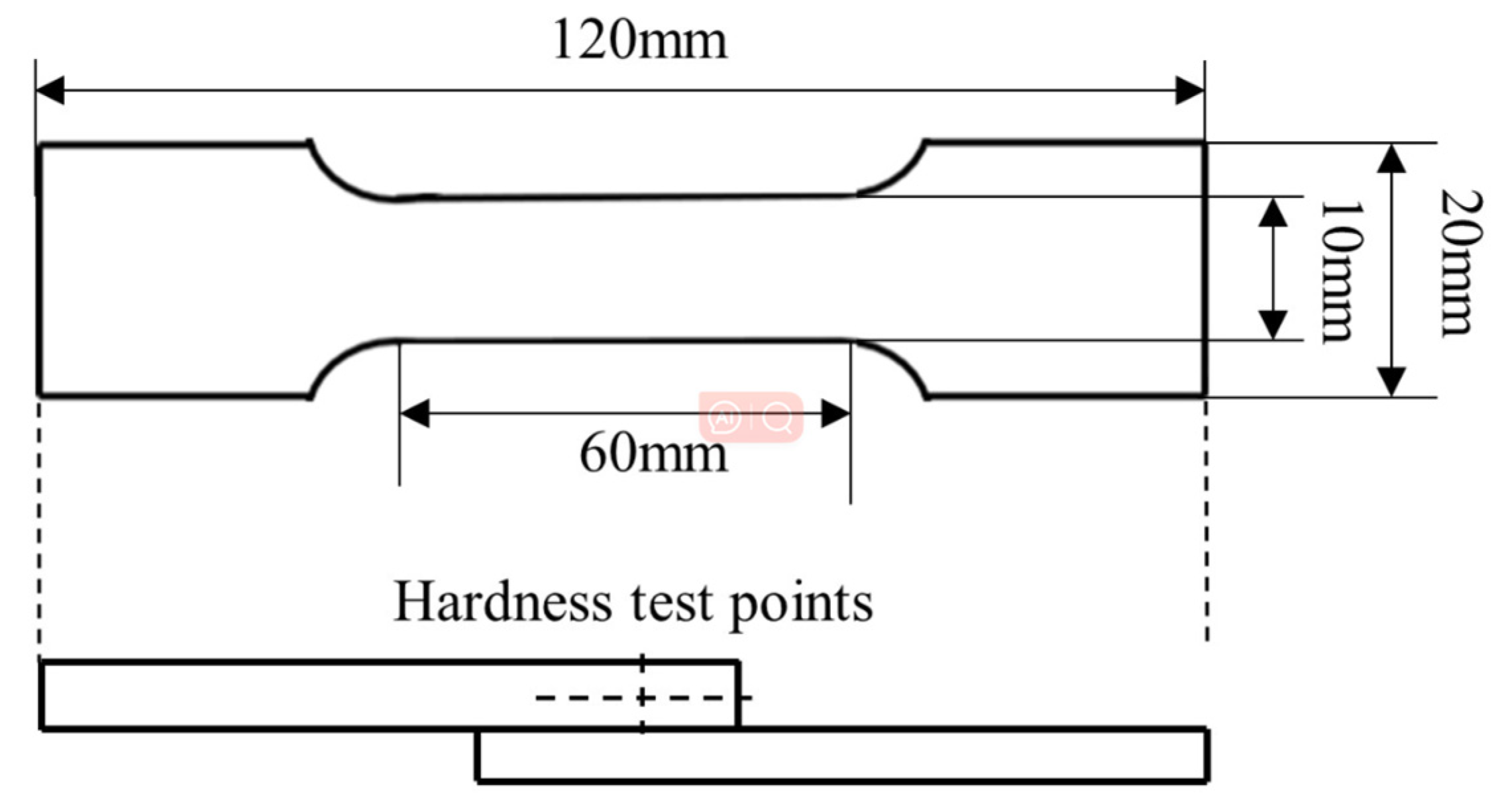

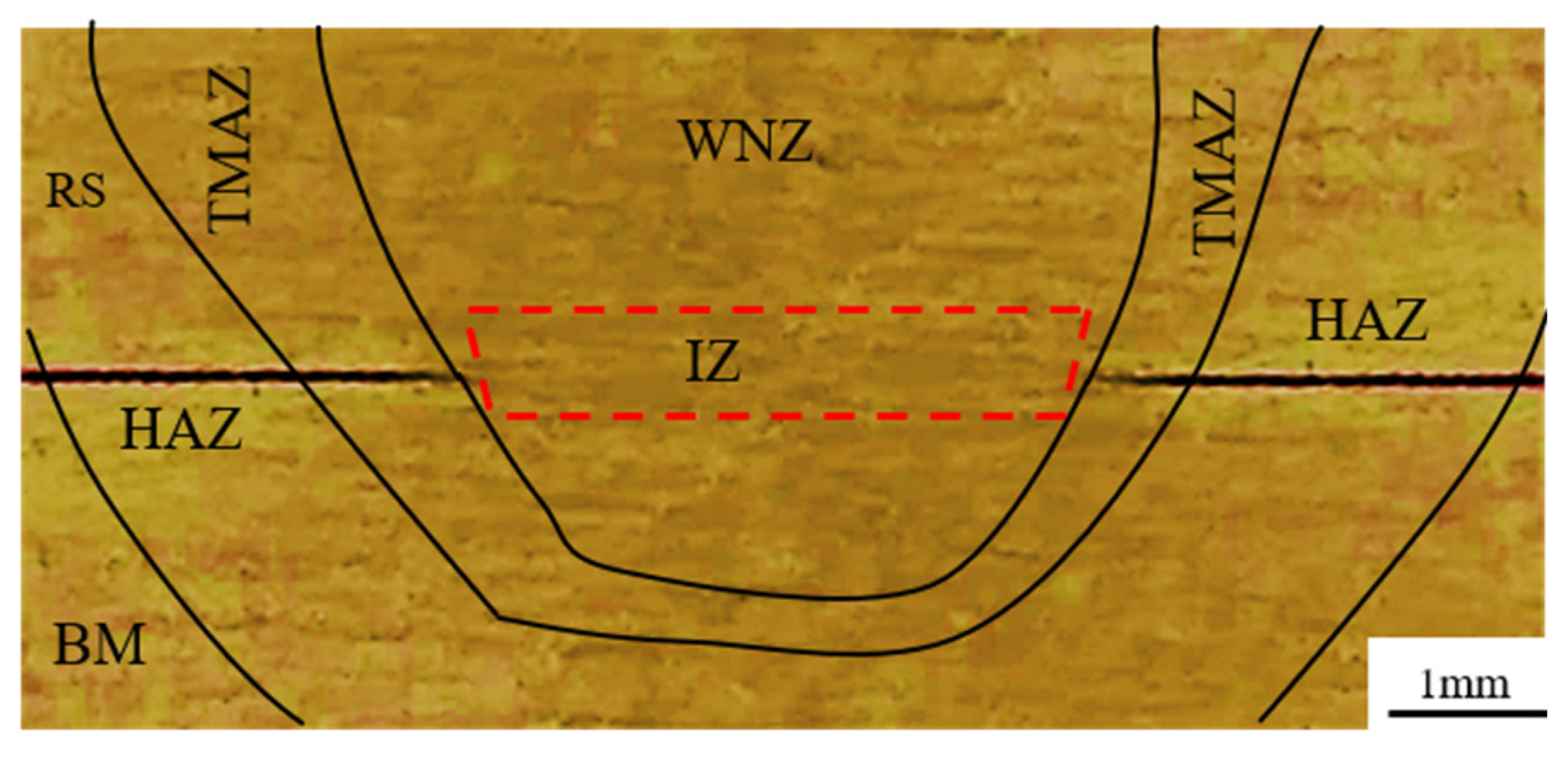

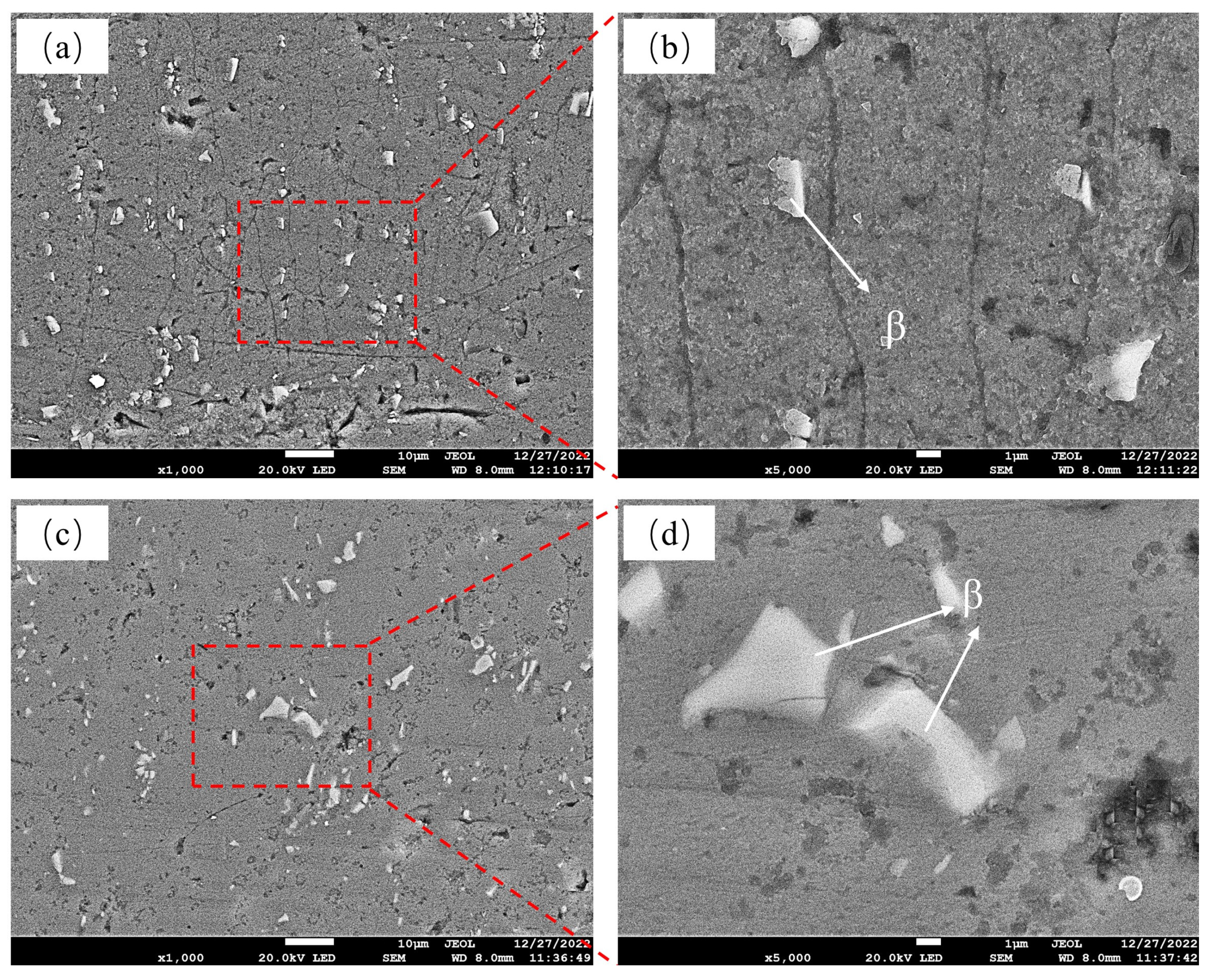
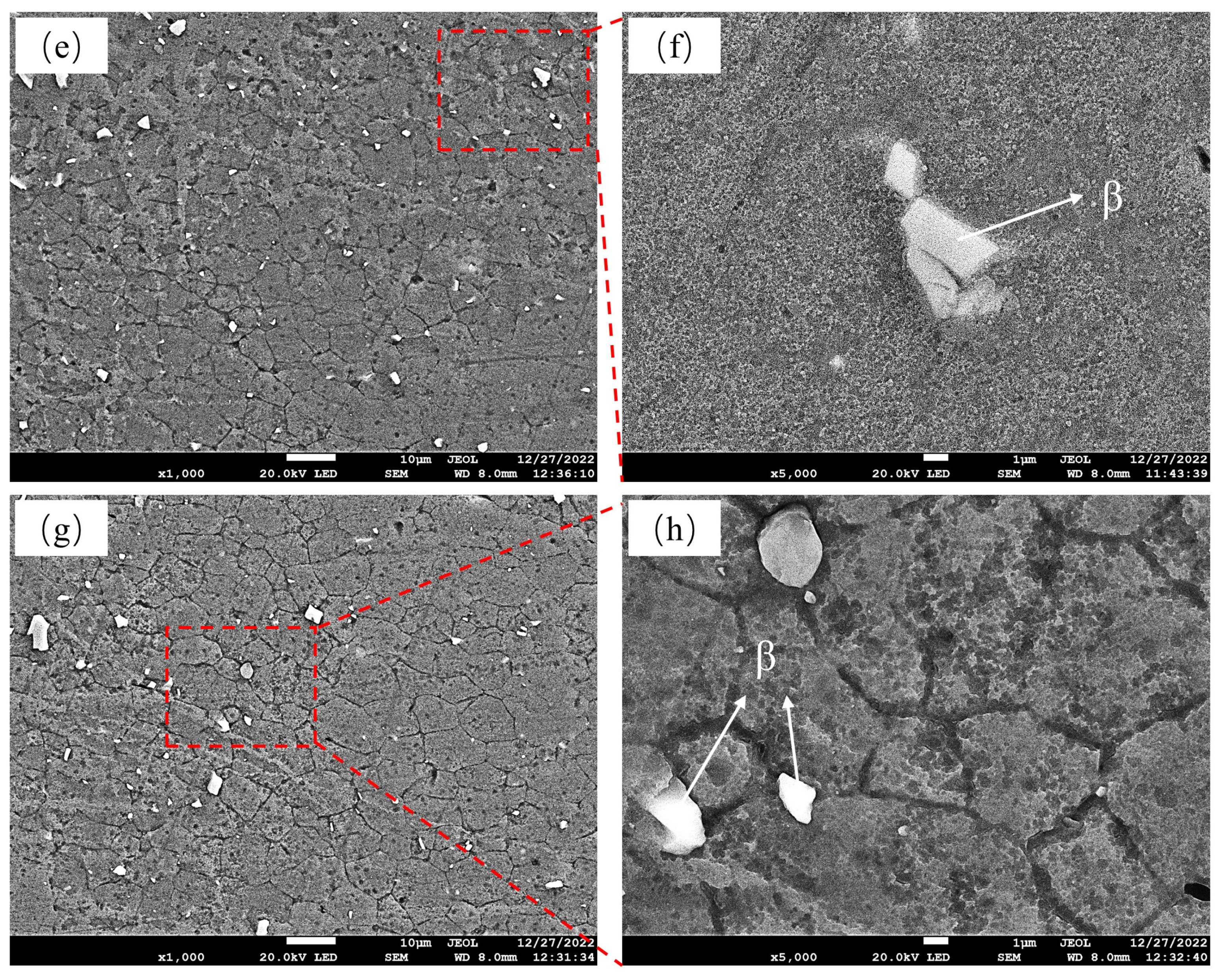
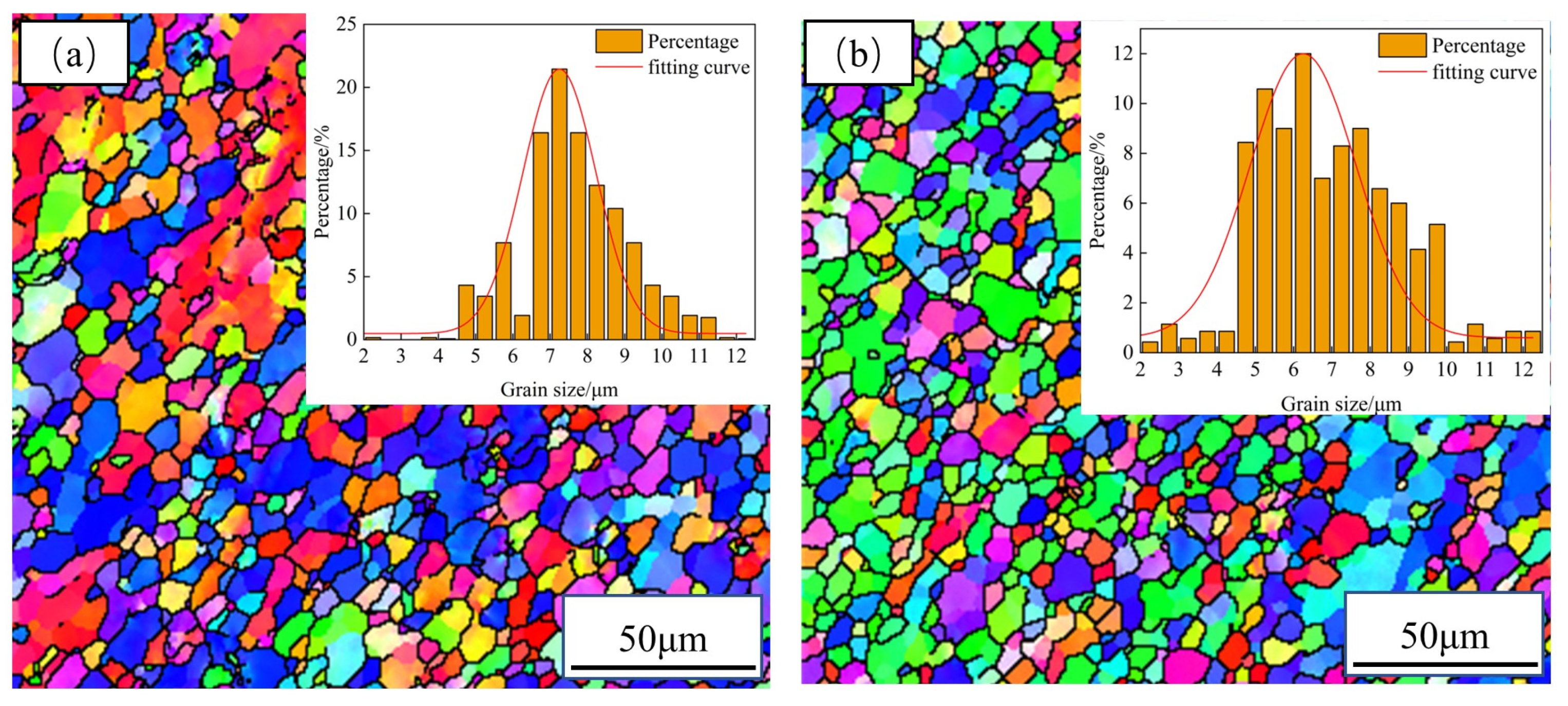
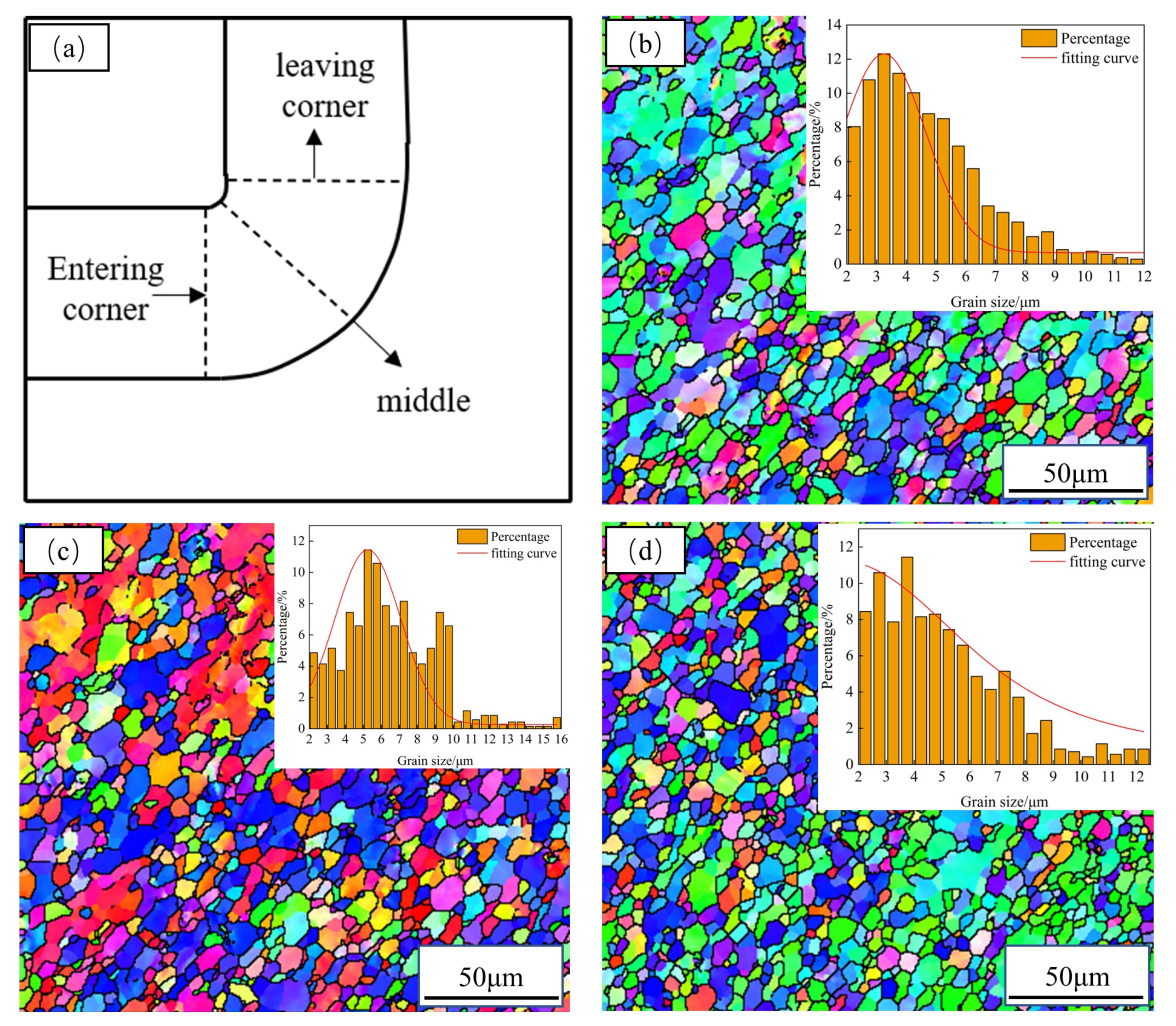
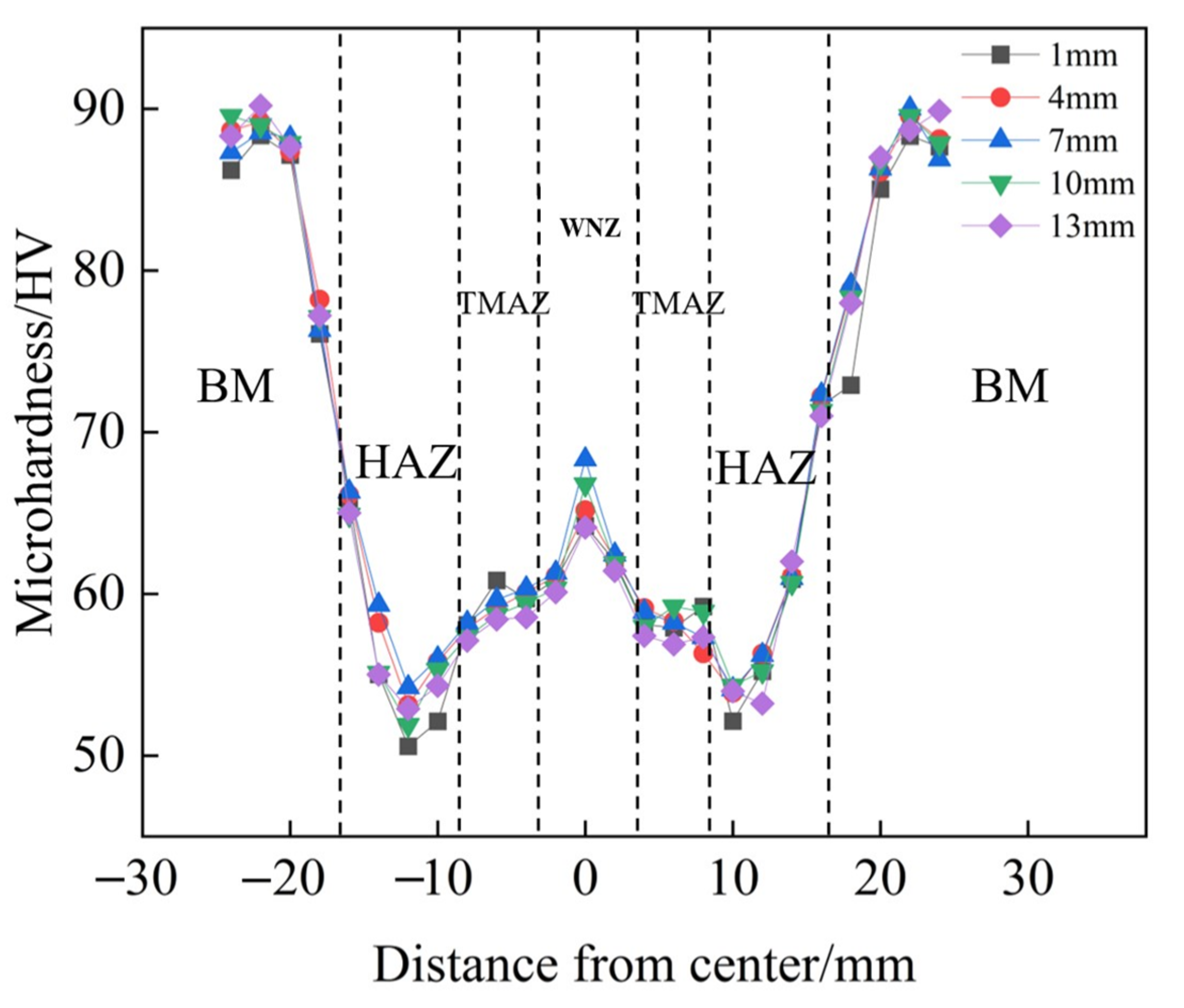
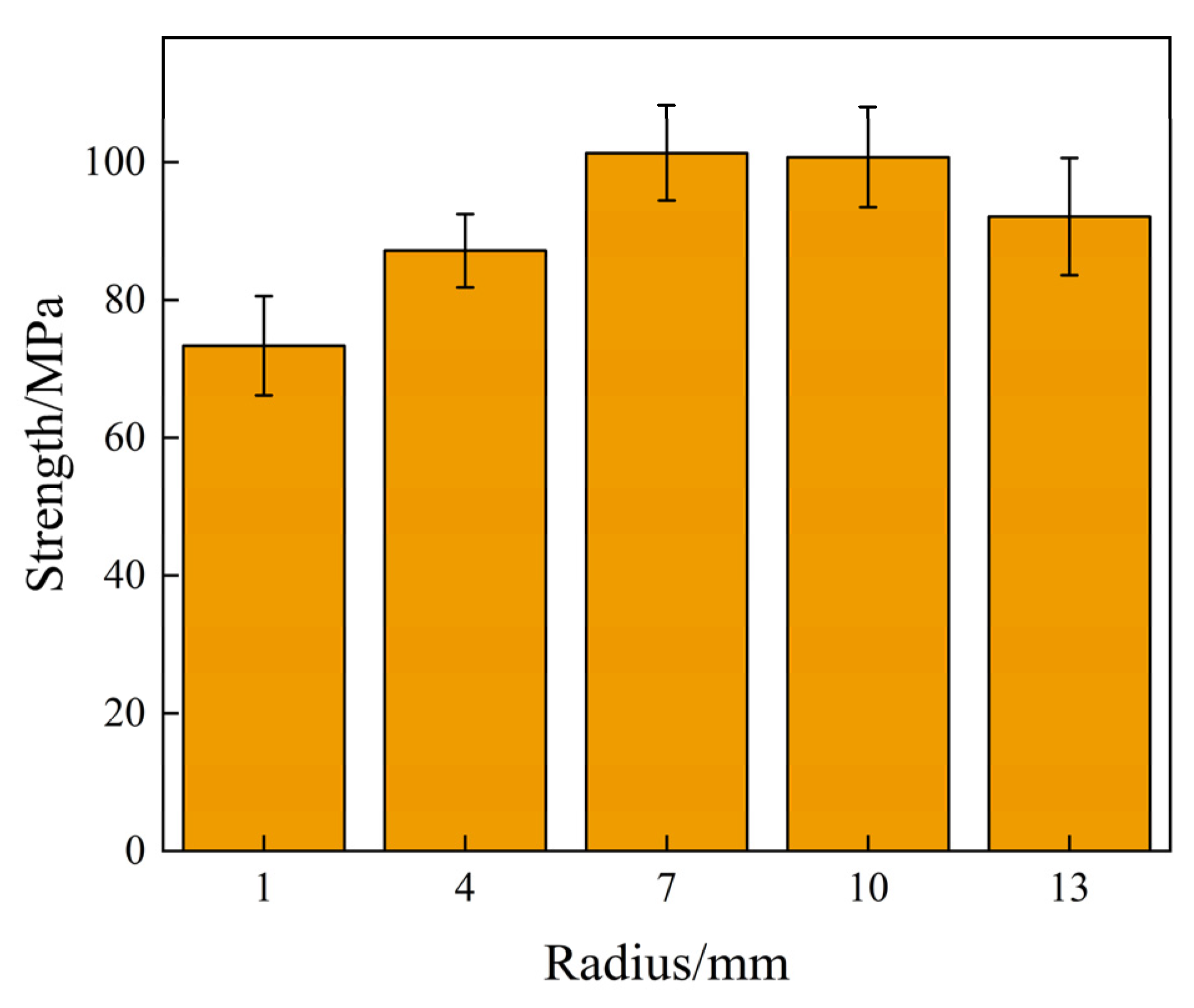
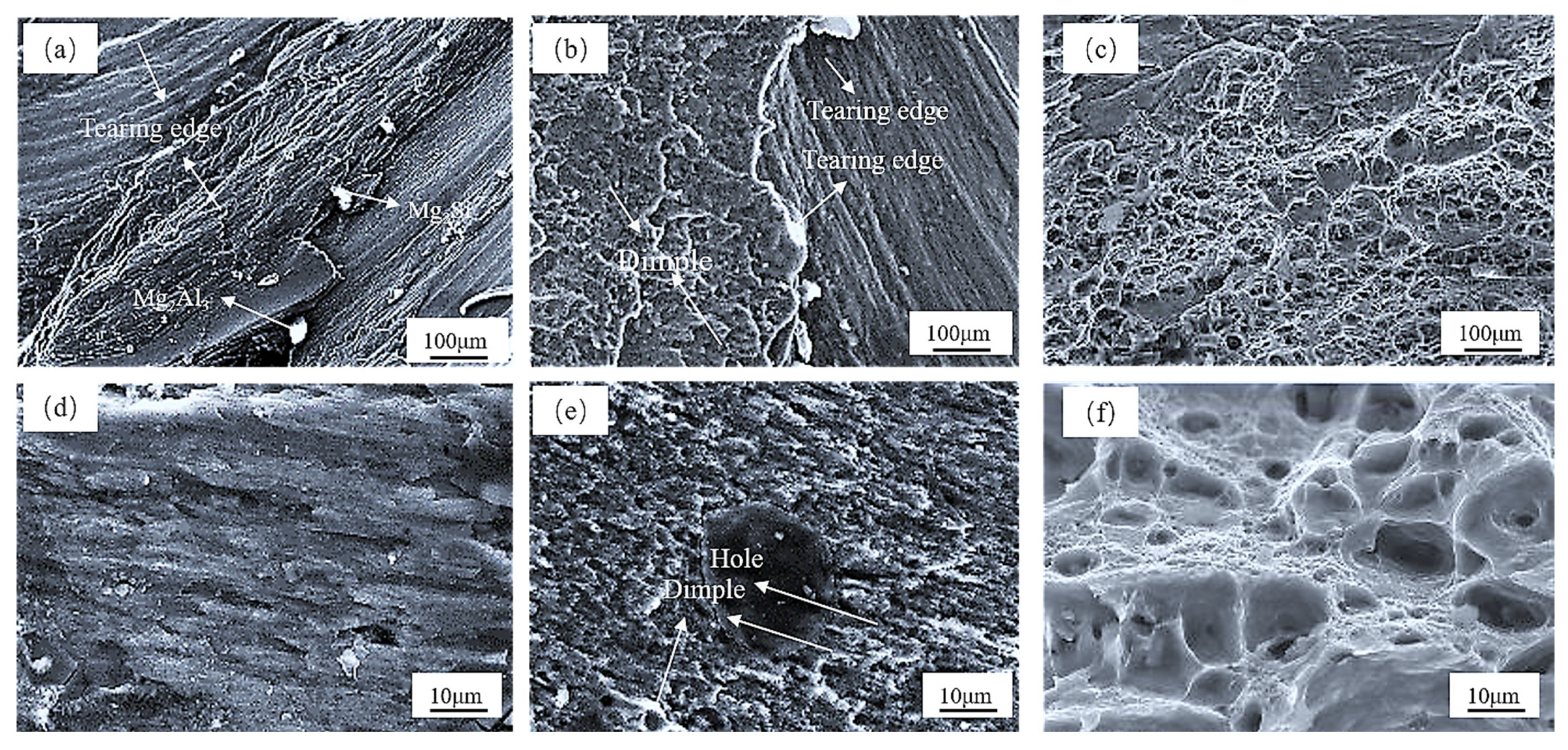
| Mg | Si | Mn | Fe | Cr | Zn | Cu | Ti | Al |
|---|---|---|---|---|---|---|---|---|
| 1.1 | 0.58 | 0.12 | 0.35 | 0.22 | 0.01 | 0.28 | 0.019 | Bal |
| Material | Yield Strength (MPa) | Tensile Strength (MPa) | Microhardness (HV0.49N) | Elongation (%) |
|---|---|---|---|---|
| 6061-T6 | 235 | 283 | 105 | 26.4 |
Disclaimer/Publisher’s Note: The statements, opinions and data contained in all publications are solely those of the individual author(s) and contributor(s) and not of MDPI and/or the editor(s). MDPI and/or the editor(s) disclaim responsibility for any injury to people or property resulting from any ideas, methods, instructions or products referred to in the content. |
© 2023 by the authors. Licensee MDPI, Basel, Switzerland. This article is an open access article distributed under the terms and conditions of the Creative Commons Attribution (CC BY) license (https://creativecommons.org/licenses/by/4.0/).
Share and Cite
Qu, L.; Ma, N.; Xiao, X.; Zhang, K.; Li, H. Microstructure and Properties of Nonlinear Lap Joint of 6061 Aluminum Alloy by Friction Stir Welding. Metals 2023, 13, 1494. https://doi.org/10.3390/met13081494
Qu L, Ma N, Xiao X, Zhang K, Li H. Microstructure and Properties of Nonlinear Lap Joint of 6061 Aluminum Alloy by Friction Stir Welding. Metals. 2023; 13(8):1494. https://doi.org/10.3390/met13081494
Chicago/Turabian StyleQu, Laipeng, Ning Ma, Xiao Xiao, Keke Zhang, and Huijun Li. 2023. "Microstructure and Properties of Nonlinear Lap Joint of 6061 Aluminum Alloy by Friction Stir Welding" Metals 13, no. 8: 1494. https://doi.org/10.3390/met13081494




